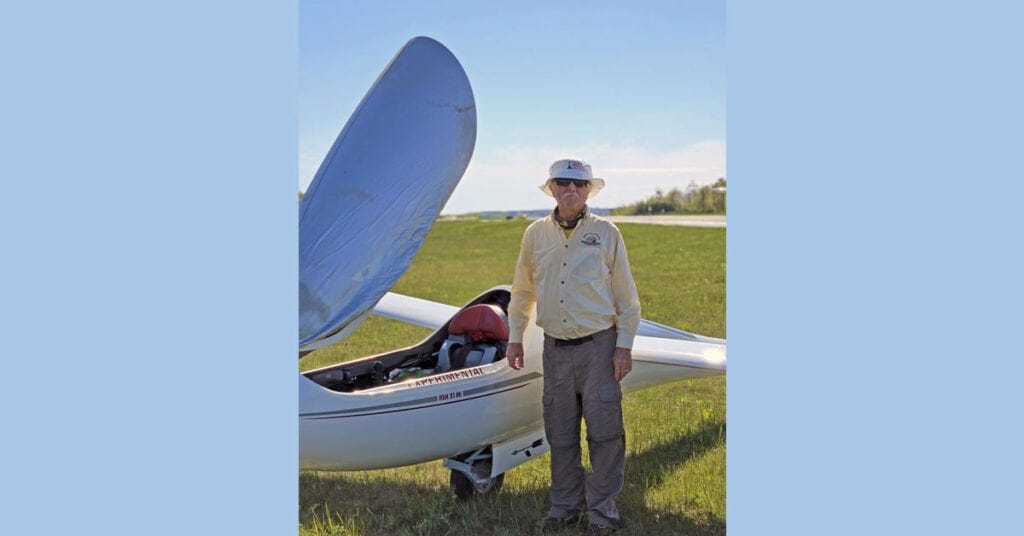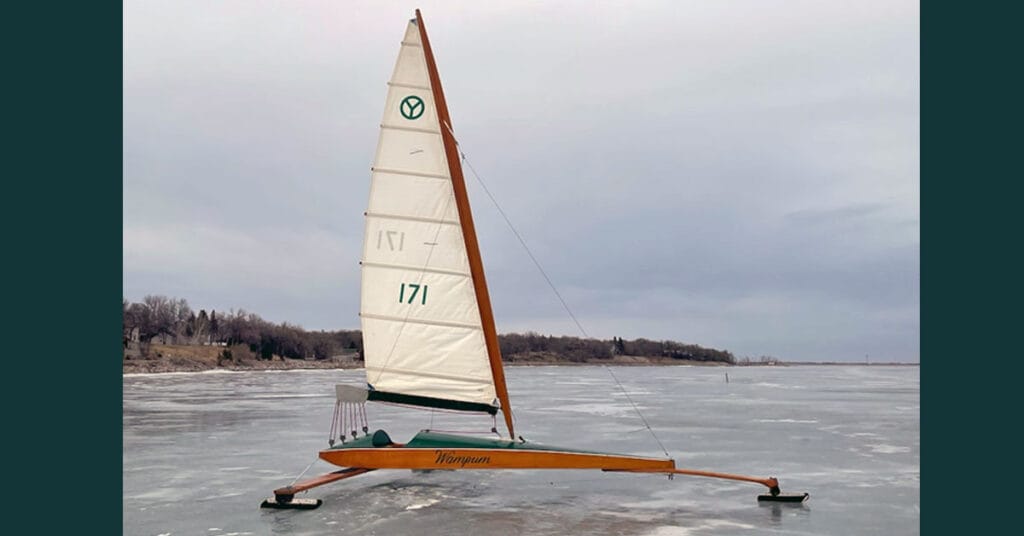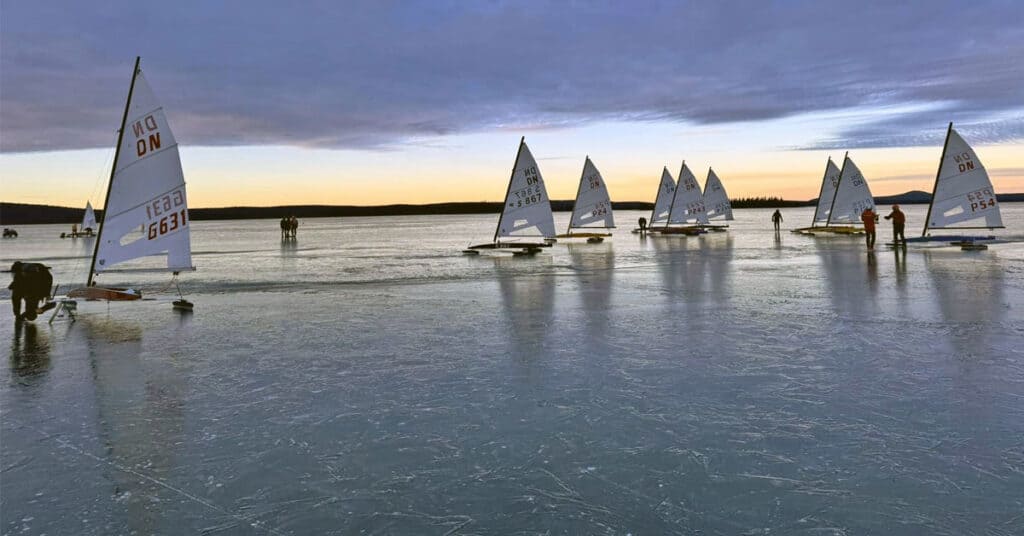by Deb Whitehorse | May 29, 2025 | 2024-2025, Home Page

Chicago to Mackinac started early this year when retired Renegader Glenn Betzoldt decided to organize his own race—not by iceboat or soft water sailboat, but with his glider plane.
Well, I never did the sailboat soft water race to the Island, so I decided to start my own race, first ever Michigan Sailplane “air sailing” race to Mackinac. So Memorial Day, I finally got the forecast I needed to go.
I started west of North Cape Yacht club and another Sailplane came out of Ann Arbor to join me. So, we had 2 classes, Open& 18 Meter, but the 18 Meter ended up dropping out.
So, then it wasn’t a speed race, this time just distance, about 275 miles start to finish. I guess you could say I was in the Cruisers Class.
It worked out great, and had enough altitude to cross the straits without any sweat. My biggest concern of the trip was all the landing lights I had to deal with since I have a 70’ wingspan. (144 sq feet sail area) The lights on the island were about 2 feet tall with an additional 2 feet for flags on top of that – to help find them in the winter under the snow.
To get the glider off the Island, I didn’t want to use horses to pull the trailer off the ferry and get it to the airport $$$. So, after spending the night on the island, I did a self-launch off Mackinac to move the glider to Cheboygan. My wife, Laura, drove up with the trailer and we de-rigged and drove back home.
It was a once in a lifetime Sailplane flight!!
Glen

Another way to sail the Great Lakes, a concept painting by Harry Whitehorse titled “Great Lakes Freighter.”
Like this:
Like Loading...
by Deb Whitehorse | May 9, 2025 | 2024-2025, Home Page, WSSA

Monotype XV Archives
4LIYC Vice Commodore and Renegader Ron Rosten typically travels to Europe each year for the DN and Ice Optimist Junior World Championship. With this year’s event postponed until December 2025, Ron already had his airline tickets to Sweden—so he made the best of it. He met up with friends and attended the Monotype World Championship instead.
In case you aren’t familiar with the Monotype XV: it’s a two-person ice yacht with deep roots in European ice sailing. As described on a previous version of Monotype website:
“The Monotype-XV ice yacht was designed in 1932 by the legendary Erik von Holst of Estonia. It became popular in a very short time, and more than 200 yachts were built in but a few years. The yacht is a strict monotype construction; in broad outline, it looks the same as in the nineteen thirties. The structural elements are nowadays joined by modern methods and the use of epoxy adhesive. The bronze runners have been replaced by runners in stainless steel. The sail is of course made of Dacron or an equivalent material. The Monotype-XV is the largest monotype class in Europe today, and the only yacht for two for which European as well as international championships are arranged.”
Specs: Sail area: 15 m² | Length: 7.5 m | Width: 4.2 m | Mast height: 7.2 m | Minimum weight: 205 kg | Crew: 1–2 persons
Monotype XV website
Here’s Ron’s report from the trip, originally shared on our Facebook page.
I forgot to post this back in February so I’ll post these photos now. I was in Sweden this past February and spent 2 days visiting the 2025 Monotype-XV Class Championship. There were 26 boats competing that week on one of the very few sailable lakes in Europe, Lake Storsjön near Sandviken.
The first day I was there was a practice day. In a Monotype regatta, all boats start on a port tack and round the bottom mark in a clockwise direction. Another oddity is the crew member sits facing backwards. The Swedish boat S-29 is the defending champion sailed by Bernhard Rost and crewed by Thomas Tennstrom. They would finish 2nd in this year’s regatta.
There were 2 boats that were made available to junior sailors at the regatta. Probably the talk of the regatta was a boat sailed by 2 Swedish juniors, who happened to be female. Hedvig Liljegren was the skipper and Ellen Fredriksson was her crew. They had a grand total of 1 weekend of practice in the boat before the regatta and finished a very respectable 13th overall. Both are very experienced soft water sailors and are training for the 2028 Olympics. [Speaking of Olympics – the Monotype was the iceboat of choice under consideration for the 1936 Olympics. Story here. – About Hedvig and Ellen – About the Sailors: Hedvig Liljegren and Ellen Fredriksson are top-tier Swedish sailors training for the 2028 Olympics. You can follow Hedvig’s Olympic campaign with her brother Hugo on Instagram – Ed.]
Like this:
Like Loading...
by Deb Whitehorse | Apr 12, 2025 | 2024-2025, Home Page

When 4LIYC Nite sailors Lars Barber and Brad Wagner hit the road for land or ice sailing events, they don’t just set the cruise control and blast down the highway. These two turn every road trip into a treasure hunt—stopping at flea markets, poking around small towns, and always keeping an eye out for something unusual. On their return from the 2025 Blokart North Americans, they pulled into a hotel in Cimarron, New Mexico—and sure enough, Lars spotted something unexpected: an old black-and-white photo of a stern steerer iceboat hanging on the wall with the caption: “Mr. Whitney’s ice boat on Cimmeron (French) Lake.”
New Mexico isn’t typically known for iceboating, but French Lake, situated in the Sangre de Cristo Mountains near Cimarron, is located at an elevation of about 6,300 feet. At this altitude, small lakes can freeze during the winter.
Using old newspaper and genealogy archives, I tracked down “Mr. Whitney.” He was Frederic Whitney, born in 1879 in Iowa. His father and ancestors were from Maine, so he possibly brought that knowledge with him when he moved west. During his time in New Mexico in the early 1900s, Whitney became a prominent local figure. One article even noted that he had installed a tennis court at his ranch, showing his passion for sports and outdoor life. Later in life, he moved to Alaska and died on the Kenai Peninsula in 1978 at 99.
Though I couldn’t find any specific record of Whitney iceboating, I sent the photo to iceboating sailmaker and historian Henry Bossett to get his take. Henry pointed out that Mr. Whitney appears to be sailing while standing up—an unusual style. (Perhaps a windless day?) He also noted the rig features a jib-headed topsail, a small triangular sail used on gaff rigs and set between the gaff and the mast. In the sport’s early days, some iceboaters repurposed their summer sailing rigs and mounted them on iceboat frames. Henry shared a historical example of a similar setup, included below.
While we may never learn much more about Frederic Whitney’s brief moment on the ice at French Lake, it remains another interesting footnote in the unexpected history of ice sailing.

Example of jib-headed top sails.
Like this:
Like Loading...
by Deb Whitehorse | Mar 26, 2025 | 2024-2025, Home Page, ISA
 Many of us who have attended the DN Western Challenge in Minnesota have seen the beautiful Yankee iceboat that always turns heads. It belongs to Regan Schwaen, who makes the drive from North Dakota each year. Regan gives rides, welcomes questions, and is clearly someone who takes pride in keeping the boat in top condition.
Many of us who have attended the DN Western Challenge in Minnesota have seen the beautiful Yankee iceboat that always turns heads. It belongs to Regan Schwaen, who makes the drive from North Dakota each year. Regan gives rides, welcomes questions, and is clearly someone who takes pride in keeping the boat in top condition.
For years, I’ve wondered about the possibility of sailing on Devil’s Lake, North Dakota. Now Regan has done it—and sent in this report:
Regin Schwaen lives in Fargo, North Dakota and sailed his Yankee B-class skeeter for the first time on Devils Lake this weekend. Trailer and iceboat had already been prepared for a visit to Wisconsin and his friend Doug Anderson had just arrived from California, but ice and wind altered the plan. Still bitten by the iceboat bug they used the NDTC webcam installed at the Lakewood public boat landing on northern Devils Lake for a rough estimate regarding ice conditions. Devils Lake in North Dakota is not an easy lake to sail because it is so large, but the ramp was in perfect order, and they found 16” of excellent ice. The first day presented awesome sailing conditions that perhaps would have been acceptable for a regatta. The next day the lake was covered with 3/4 inches of snow making if difficult to evaluate the old ice beyond Creel Bay that spills into Devils Lake. Top speed on the second day was around 35 knots. Regin Schwaen is still quite new to iceboating and this year ISA presented him with the number 171 that he now sails under. This was the first time it was safe to sail on Devils Lake this season and perhaps a first for a Yankee iceboat to sail in North Dakota as well.
Like this:
Like Loading...
by Deb Whitehorse | Nov 14, 2024 | 2024-2025, DN, Home Page

Or should we say it in Finnish, Ensimmäinen! Via Swedish DNer Dideric Van Riemsdijk, here’s a look at the first runners on the ice at the first regatta of the season, DN Finland’s Week 46. They are just above the Arctic Circle at Onkamojärvi, Finland. Who will be the FIRST in North America?
Like this:
Like Loading...
















 Many of us who have attended the DN Western Challenge in Minnesota have seen the beautiful Yankee iceboat that always turns heads. It belongs to Regan Schwaen, who makes the drive from North Dakota each year. Regan gives rides, welcomes questions, and is clearly someone who takes pride in keeping the boat in top condition.
Many of us who have attended the DN Western Challenge in Minnesota have seen the beautiful Yankee iceboat that always turns heads. It belongs to Regan Schwaen, who makes the drive from North Dakota each year. Regan gives rides, welcomes questions, and is clearly someone who takes pride in keeping the boat in top condition.

